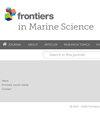Plasticity under pressure: the influence of shear stress on larval echinoid morphogenesis
IF 3
2区 生物学
Q1 MARINE & FRESHWATER BIOLOGY
引用次数: 0
Abstract
IntroductionIndividuals of some marine species can modify their phenotype in response to environmental factors, allowing them to adapt to new conditions throughout their ontogeny. Echinoids represent an ecologically significant taxon that exhibit such plasticity throughout a biphasic life history in response to known biotic and abiotic factors. Preliminary lab-based observations have suggested that morphological traits, specifically pluteal arm length, may be influenced by physical processes such as hydrodynamic flow during planktotrophic larval development. This dynamic remains understudied despite potentially critical demographic implications.MethodsHere, we tested the effect of continuous exposure to different shear stress treatments on larval morphology and life history timing shifts in three co-occurring species:压力下的可塑性:剪切应力对棘卵类幼虫形态发生的影响
一些海洋物种的个体可以根据环境因素改变其表型,使它们能够在整个个体发育过程中适应新的条件。棘刺类是一种重要的生态分类,在生物和非生物因素的双重影响下,在整个生活史中表现出这种可塑性。基于实验室的初步观察表明,形态特征,特别是羽臂长度,可能受到浮游营养化幼虫发育过程中流体动力流动等物理过程的影响。尽管这种动态可能具有关键的人口统计学意义,但仍未得到充分研究。方法研究了连续暴露于不同剪应力处理下对三种共发生物种(Lytechinus variegatus、Tripneustes osus和Diadema antillarum)幼虫形态和生活史时间变化的影响。结果在较大剪切作用下,心室田鼠和抗顶田鼠均表现出较长的后臂和较强的变质能力。对变异乳杆菌未见治疗效果。这些发现首次观察到棘皮动物幼虫对水动力因素的形态发生可塑性反应。物种特异性效应揭示了一个可塑性连续体,该连续体可能由系统发育、生态位和/或功能形态介导。这种动态反应提供了对幼虫扩散和招募潜力,成虫分布以及生态相关的棘皮类种群的盛衰周期特征的见解。
本文章由计算机程序翻译,如有差异,请以英文原文为准。
求助全文
约1分钟内获得全文
求助全文
来源期刊

Frontiers in Marine Science
Agricultural and Biological Sciences-Aquatic Science
CiteScore
5.10
自引率
16.20%
发文量
2443
审稿时长
14 weeks
期刊介绍:
Frontiers in Marine Science publishes rigorously peer-reviewed research that advances our understanding of all aspects of the environment, biology, ecosystem functioning and human interactions with the oceans. Field Chief Editor Carlos M. Duarte at King Abdullah University of Science and Technology Thuwal is supported by an outstanding Editorial Board of international researchers. This multidisciplinary open-access journal is at the forefront of disseminating and communicating scientific knowledge and impactful discoveries to researchers, academics, policy makers and the public worldwide.
With the human population predicted to reach 9 billion people by 2050, it is clear that traditional land resources will not suffice to meet the demand for food or energy, required to support high-quality livelihoods. As a result, the oceans are emerging as a source of untapped assets, with new innovative industries, such as aquaculture, marine biotechnology, marine energy and deep-sea mining growing rapidly under a new era characterized by rapid growth of a blue, ocean-based economy. The sustainability of the blue economy is closely dependent on our knowledge about how to mitigate the impacts of the multiple pressures on the ocean ecosystem associated with the increased scale and diversification of industry operations in the ocean and global human pressures on the environment. Therefore, Frontiers in Marine Science particularly welcomes the communication of research outcomes addressing ocean-based solutions for the emerging challenges, including improved forecasting and observational capacities, understanding biodiversity and ecosystem problems, locally and globally, effective management strategies to maintain ocean health, and an improved capacity to sustainably derive resources from the oceans.
 求助内容:
求助内容: 应助结果提醒方式:
应助结果提醒方式:


